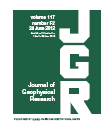
JOURNAL OF GEOPHYSICAL RESEARCH-EARTH SURFACE
Scope & Guideline
Advancing Knowledge in Geophysical Research.
Introduction
Aims and Scopes
- Geomorphological Processes:
Research on the physical processes that shape the Earth's surface, including erosion, sedimentation, and landform development. - Sediment Transport Dynamics:
Studies focusing on the mechanics of sediment transport in various environments, including rivers, glaciers, and coastal areas. - Climate Change Impact Assessment:
Investigations into how climate change influences surface processes, including glacial retreat, vegetation shifts, and hydrological changes. - Remote Sensing and Geophysical Techniques:
Utilization of advanced technologies such as satellite imagery, lidar, and seismic methods to analyze and monitor Earth surface changes. - Numerical and Physical Modeling:
Development and application of models to simulate surface processes, including sediment transport, hydrology, and geomorphological evolution. - Permafrost and Cryospheric Studies:
Research on the dynamics of permafrost and its impact on landscape morphology and sediment transport. - Natural Hazards and Risk Assessment:
Analysis of geomorphic responses to natural hazards such as landslides, floods, and earthquakes, and their implications for risk management.
Trending and Emerging
- Machine Learning Applications:
Increasing utilization of machine learning techniques for analyzing geomorphological data, enhancing predictive modeling, and automating classification tasks. - Impact of Anthropogenic Activities:
Growing research on how human activities, such as urbanization and land use change, affect sediment transport and landscape evolution. - Integrated Climate-Sediment Dynamics:
Emerging studies that link climate variability with sediment dynamics, focusing on how changing climate patterns influence erosion and deposition. - Geophysical Monitoring Techniques:
Adoption of advanced geophysical methods, including seismic and electrical resistivity imaging, to monitor and understand subsurface processes. - Coastal and Marine Geomorphology:
Increased attention on coastal processes, particularly regarding sea-level rise, sediment dynamics, and the resilience of coastal ecosystems. - Permafrost Research in a Warming Climate:
A surge in studies examining the effects of climate change on permafrost dynamics and the resulting geomorphic implications. - Cross-Disciplinary Approaches:
Emergence of research that integrates geology with biology, ecology, and hydrology to provide a more holistic understanding of earth surface processes.
Declining or Waning
- Historical Geomorphology:
Research focusing on historical landforms and their evolution over long timescales has become less frequent, possibly due to a shift towards more immediate environmental concerns. - Traditional Geological Mapping:
Studies relying solely on conventional geological mapping techniques have waned, as modern methods and technologies are increasingly favored. - Tectonic Geomorphology:
Although still relevant, the prominence of tectonic influences on surface processes may have diminished as attention shifts towards climate-driven changes. - Static Landscape Analysis:
Research that does not incorporate dynamic processes or time-dependent changes in landscapes has become less prevalent, with a greater emphasis now on temporal analysis.
Similar Journals

Frontiers of Earth Science
Elevating Earth Science Research to New HeightsFrontiers of Earth Science is a prominent academic journal in the field of Earth and Planetary Sciences, published by Springer. With an ISSN of 2095-0195 and an E-ISSN of 2095-0209, this journal serves as a significant platform for researchers and professionals to disseminate their findings from 2007 to 2024. It is recognized for its impactful contributions within the category of Earth and Planetary Sciences, boasting a respected Q2 ranking in 2023. With a Scopus ranking of 64 out of 195, placing it in the 67th percentile, Frontiers of Earth Science continues to drive academic dialogue and innovation. The journal is dedicated to exploring a diverse range of topics, including geology, meteorology, and environmental science, and amplifying the understanding of Earth systems through rigorous research. Located in New York, USA, this journal embraces an Open Access model, ensuring that groundbreaking research is readily available to the global scientific community, thereby enhancing its accessibility and impact.

Morphology
Exploring the Intricacies of Language MorphologyMorphology is a leading academic journal published by Springer, dedicated to the field of linguistics and language, with an impressive 2023 Category Quartile of Q1 reflecting its high impact and quality. Established in 2006, this international journal presents cutting-edge research and advancements in morphological studies, providing a vital platform for scholars and practitioners to disseminate their findings and insights. With its Scopus rank placing it in the top 10% of journals in the Arts and Humanities (Language and Linguistics), Morphology plays a pivotal role in shaping the discourse within the field. The journal maintains a commitment to excellence and rigor, catering to a wide readership that includes researchers, professionals, and graduate students eager to explore the complexities of language structure. Although currently not open access, Morphology ensures that its content is accessible through various institutional subscriptions, facilitating widespread engagement with important linguistic research.

OCEAN DYNAMICS
Pioneering Research for a Sustainable OceanOCEAN DYNAMICS is a premier peer-reviewed journal published by Springer Heidelberg, dedicated to advancing the field of oceanography. With an ISSN of 1616-7341 and an E-ISSN of 1616-7228, the journal has established itself as a key resource for researchers and professionals interested in the dynamic processes of the world's oceans. As of 2023, it holds an impressive Q2 category ranking in Oceanography, placing it among the top journals in its field (Rank #34/145, 76th percentile in Earth and Planetary Sciences). Although operating under a traditional publishing model without open access options, OCEAN DYNAMICS continues to provide valuable insights and a platform for innovative research, boasting coverage from 2001 to 2024. Researchers and students alike will benefit from this journal's commitment to showcasing cutting-edge studies that enhance our understanding of oceanographic phenomena.

Sciences in Cold and Arid Regions
Innovating solutions for cold and arid challenges.Sciences in Cold and Arid Regions, published by SCIENCE PRESS, is a pivotal open-access journal dedicated to advancing the understanding of environmental science and engineering in cold and arid environments. With an ISSN of 1674-3822, this journal provides a platform for researchers to share innovative studies and breakthroughs that address the unique challenges faced in these regions, encompassing vital areas such as earth-surface processes and environmental engineering. Although its coverage in Scopus has been discontinued since 2022, it continues to maintain importance within its specialized field, as evidenced by its rankings among other environmental science and earth sciences journals. By embracing open access, Sciences in Cold and Arid Regions ensures that cutting-edge research is freely available to a global audience, fostering collaboration and knowledge exchange among professionals and students alike, and emphasizing the critical need for adaptable strategies in managing cold and arid ecosystems.
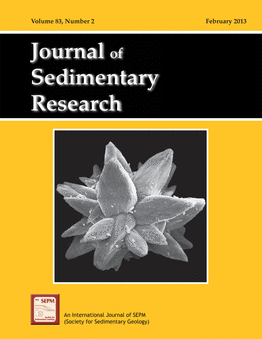
JOURNAL OF SEDIMENTARY RESEARCH
Exploring the Depths of Sedimentary ScienceThe JOURNAL OF SEDIMENTARY RESEARCH, published by SEPM-SOCIETY FOR SEDIMENTARY GEOLOGY, stands as a pivotal peer-reviewed journal in the field of sedimentary geology. With an ISSN of 1527-1404 and an E-ISSN of 1938-3681, this esteemed journal features a broad scope, delving into the intricacies of sedimentary processes, lithology, and stratigraphy since its inception in 1931. Enjoying a distinguished reputation, it has achieved a Q1 category ranking in Geology for 2023 and ranks 87 out of 321 in Earth and Planetary Sciences, placing it in the 73rd percentile among its peers in Scopus. With continued access options available, it facilitates the dissemination and discussion of cutting-edge research that shapes the understanding of sedimentary phenomena. Researchers, professionals, and students alike benefit from this critical platform that fosters academic engagement and drives progress within the field.

Revista Brasileira de Geomorfologia
Exploring the Dynamics of Earth's SurfaceRevista Brasileira de Geomorfologia is a prominent open-access journal dedicated to the field of geomorphology, fostered by the UNIAO GEOMORFOLOGIA BRASILEIRA since its inception in 2000. Based in Brazil, this journal serves as a vital platform for researchers, professionals, and students to disseminate and engage with cutting-edge research on the dynamic processes shaping the Earth's surface. With an ISSN of 1519-1540 and an E-ISSN of 2236-5664, it has earned its place within the academic community, ranking in the Q3 category in the Earth-Surface Processes domain according to the latest 2023 quartiles. The journal's metrics, including a Scopus rank of 123/179 within its category, reflect its commitment to quality research. By facilitating open access to its content, the Revista Brasileira de Geomorfologia not only promotes scholarly communication but also enhances the visibility of vital studies detrimental to understanding geomorphological transformations and environmental change. Join the ongoing discourse and contribute to advancing knowledge in this essential field of Earth sciences.
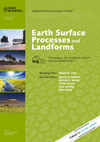
EARTH SURFACE PROCESSES AND LANDFORMS
Illuminating the Interplay Between Landforms and ProcessesEARTH SURFACE PROCESSES AND LANDFORMS is a renowned academic journal dedicated to the comprehensive exploration of dynamic processes shaping the Earth's surface. Published by Wiley, this esteemed journal has established itself as a leading platform in the fields of Earth and Planetary Sciences, Geography, Planning, and Development. With an impressive Impact Factor and ranked in the Q1 category for multiple disciplines, it consistently features cutting-edge research that contributes to the understanding of geomorphology, hydrology, and related environmental phenomena. Researchers and professionals can benefit from the journal's extensive repository of high-quality studies, making it a crucial resource for advancing knowledge in these vital areas. As it continues to converge from 1981 to 2024, EARTH SURFACE PROCESSES AND LANDFORMS remains pivotal for scholars aiming to engage in high-level discourse and discovery in Earth sciences.
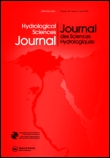
Hydrological Sciences Journal
Pioneering research in the realm of water management.Hydrological Sciences Journal, published by Taylor & Francis Ltd, is a leading peer-reviewed publication dedicated to advancing the field of hydrology, spanning topics from water management to climate impacts on hydrological systems. With an impressive impact factor and a noted Q1 category ranking in Water Science and Technology, the journal occupies a pivotal role in the academic landscape, facilitating high-quality research dissemination since its inception in 1982. The journal is indexed in Scopus, holding a commendable rank of #48 out of 261 in the Environmental Science category, placing it in the 81st percentile among its peers. Although it does not offer Open Access options, the journal ensures extensive reach and readership through institutional subscriptions. As it converges toward its milestone of 2024, the Hydrological Sciences Journal remains an indispensable resource for researchers, professionals, and students eager to explore the latest advancements and methodologies in hydrological research.
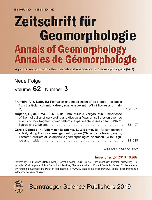
ZEITSCHRIFT FUR GEOMORPHOLOGIE
Unveiling Nature's Sculptors: The Science of Geomorphology.ZEITSCHRIFT FUR GEOMORPHOLOGIE is a prestigious journal dedicated to the field of geomorphology, published by GEBRUDER BORNTRAEGER from Germany. With the ISSN 0372-8854 and E-ISSN 1864-1687, this journal serves as a vital platform for researchers, professionals, and students interested in understanding the dynamic processes that shape our Earth’s surface. The journal has consistently maintained a solid academic reputation, achieving a Q3 ranking in key categories including Earth and Planetary Sciences (miscellaneous), Earth-Surface Processes, and Geography, Planning and Development as of 2023. This reflects its position within the global scientific community; ranked at #93 out of 179 in Earth-Surface Processes, contributing to crucial discussions surrounding environmental changes and landform evolution. Although ZEITSCHRIFT FUR GEOMORPHOLOGIE is not an Open Access publication, it offers extensive insights and findings from converged years spanning from 1979 to 2019 and again from 2021 to 2022. The journal is located at Johannesstr 3A, D-70176 Stuttgart, Germany, and plays a pivotal role in advancing geomorphological research that impacts natural sciences, ecology, and planning strategies worldwide.

Cryosphere
Exploring Earth's Frozen FrontiersCryosphere is a leading, peer-reviewed journal dedicated to the study of the Earth's cryospheric processes and their implications on environmental science. Published by COPERNICUS GESELLSCHAFT MBH since 2007, this open-access journal serves as a critical platform for researchers, professionals, and students interested in Earth-Surface Processes and Water Science and Technology. With an impressive impact factor and consistently ranked in the Q1 category for both Earth-Surface Processes and Water Science and Technology, Cryosphere holds a prestigious position in the global research community. The journal's scope encompasses a wide range of topics, from glaciology and snow science to the dynamics of ice bodies and their interactions with climate change. Based in Göttingen, Germany, Cryosphere not only facilitates the dissemination of high-quality research findings but also fosters interdisciplinary collaboration and dialogue among scientists and practitioners worldwide.